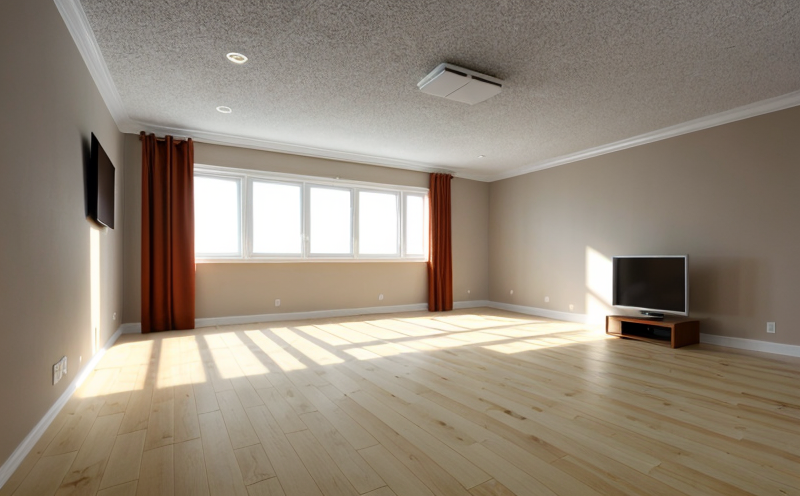EN 12354-3 Building Acoustics Facade Sound Insulation Prediction
The European Standard EN 12354-3 provides a method for predicting the sound insulation performance of building facades. This standard is particularly relevant in modern construction, where the demand for energy-efficient buildings and improved indoor environments has led to an increased focus on acoustic design.
Sound insulation prediction using EN 12354-3 involves a series of calculations based on detailed input parameters that describe the facade system. The standard is applicable to both single and multi-layered facades, covering various types including brick, concrete, and composite materials.
The methodology outlined in EN 12354-3 requires precise information about the construction elements involved. This includes the thickness of each layer of the facade, the type of material used (such as plasterboard or glass wool), and the arrangement of these layers. The standard also considers the impact of environmental factors such as wind pressure and temperature variations on sound insulation performance.
The prediction process begins with a detailed assessment of the physical properties of each component of the facade system. This includes not only static properties like density but also dynamic characteristics that can influence sound transmission, such as damping behavior. The calculations are then performed using specialized software tools designed to comply with EN 12354-3 guidelines.
The results obtained from these predictions are crucial for ensuring compliance with building regulations and achieving the desired acoustic performance levels specified by architects and engineers. Compliance with EN 12354-3 helps ensure that newly constructed buildings meet stringent noise control requirements, thereby enhancing comfort and privacy within living spaces.
Understanding the complexities involved in predicting facade sound insulation is essential for professionals working in this field. By accurately modeling different scenarios through advanced computational techniques supported by this standard, designers can make informed decisions about material selection and design modifications to optimize acoustic performance without compromising structural integrity or thermal efficiency.
In summary, EN 12354-3 offers a robust framework for predicting facade sound insulation, providing valuable insights into the behavior of various building materials under different conditions. Its application ensures that new constructions achieve optimal acoustic comfort while adhering to regulatory standards, making it an indispensable tool for architects, engineers, and other stakeholders in the construction industry.
Applied Standards
The European Standard EN 12354-3 is widely recognized as a leading benchmark for predicting facade sound insulation performance. It complements other relevant standards such as ISO 717, which provides general guidelines on building acoustics, and ISO 140, focusing on environmental aspects of products and services.
By adhering to EN 12354-3, manufacturers and constructors can ensure their projects meet stringent quality control measures. This standard supports a holistic approach towards sustainable construction practices by integrating acoustic considerations into the design phase, thus promoting healthier living environments.
The application of this particular standard also facilitates international collaboration among professionals involved in acoustics research and development globally. With its rigorous methodology grounded in scientific principles, EN 12354-3 serves as a reliable reference point for comparative studies across various regions.
Benefits
Predicting facade sound insulation through the application of EN 12354-3 offers numerous advantages that extend beyond mere compliance with regulatory requirements. One significant benefit lies in its ability to reduce development costs by identifying potential issues early in the design process.
For instance, accurate predictions enable architects and engineers to select appropriate materials and configurations more effectively than relying solely on empirical data or trial-and-error methods. This not only saves time but also minimizes the risk of costly rework during construction.
Another key advantage is enhanced client satisfaction due to improved occupant comfort levels within buildings. By ensuring effective sound insulation, occupants experience reduced noise pollution from external sources such as traffic or neighboring structures, leading to more pleasant and healthier indoor spaces.
Furthermore, compliance with EN 12354-3 contributes positively towards achieving sustainability goals set forth by various organizations. For example, it aligns well with the principles outlined in LEED (Leadership in Energy & Environmental Design) certification systems which emphasize sustainable building practices.
In conclusion, adopting this standard brings multiple benefits including cost savings, improved occupant satisfaction, and contribution to sustainability efforts – all contributing towards creating high-quality living environments that meet contemporary standards of excellence.
Customer Impact and Satisfaction
The implementation of EN 12354-3 in building projects significantly enhances customer satisfaction by delivering superior acoustic performance. Clients appreciate the assurance that their investments are aligned with stringent quality controls, regulatory compliance, and environmental sustainability.
Achieving optimal sound insulation through this standard translates directly into enhanced comfort for occupants who live or work within these structures. Reduced noise levels contribute to creating serene environments where residents can enjoy peace and quiet without being disturbed by external disturbances such as street traffic or nearby buildings.
Additionally, the use of EN 12354-3 fosters long-term value for property owners by extending the lifespan of their assets. Efficient sound management helps prevent structural damage caused by excessive vibrations over time, thereby preserving the integrity and aesthetic appeal of facades.
Beyond mere functional benefits, adhering to this standard also reinforces a brand’s reputation as a leader in sustainable construction practices. This aligns with growing consumer preferences for eco-friendly products and services, enhancing overall market perception and competitiveness.





